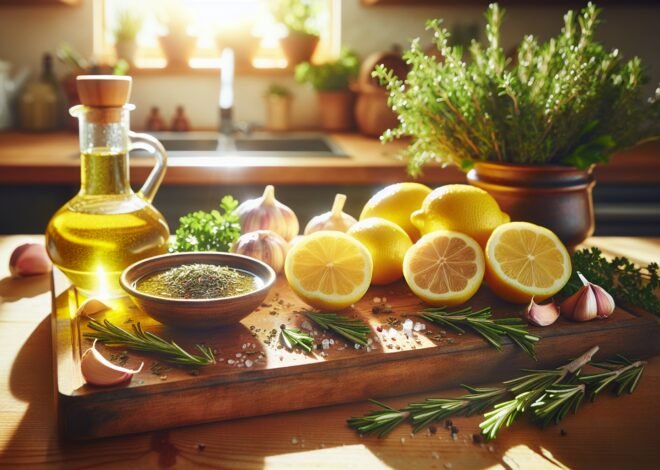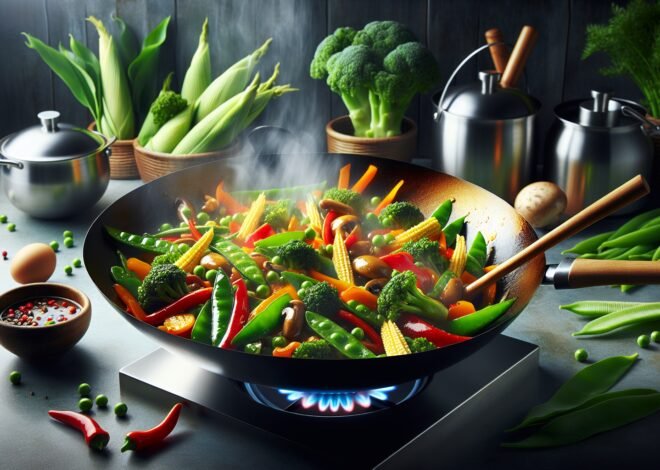
Best Fresh Herbs for Garnishing Dishes: A Visual Guide
Best herbs for garnishing add both flavor and visual appeal to dishes, transforming ordinary meals into extraordinary experiences. Imagine a dish beautifully enhanced with the vibrant greens of parsley, the intricate leaves of basil, or the subtle elegance of cilantro. This guide offers a visual tour of essential fresh herbs like mint, chives, and dill, highlighting their unique characteristics and culinary uses. Understanding which herb to use can elevate your home-cooked meals to restaurant quality, sparking creativity in the kitchen. Dive in to discover how these herbs can not only elevate taste but also add a layer of artistry to your plating.
Best Fresh Herbs for Garnishing Dishes
Fresh herbs transform ordinary dishes into culinary masterpieces. They add color, aroma, and flavor, elevating each bite. Discover the best herbs for garnishing that make your meals look and taste spectacular.
Parsley: The Versatile Garnish Herb
Parsley is more than just a decorative touch. Known for its mild flavor, it complements a variety of dishes without overpowering them. Flat-leaf parsley, in particular, enhances savory recipes with its subtle peppery taste. Curly parsley, often used for its visual appeal, adds a burst of green to any plate.
Benefits of Using Parsley:
- Rich in Vitamins: Parsley is packed with vitamin K, vitamin C, and antioxidants.
- Digestive Aid: It supports digestion and can help freshen breath.
- Culinary Uses: Sprinkle it over soups, stews, and salads for a fresh finish.
For an extra burst of flavor, try chimichurri sauce made from chopped parsley, olive oil, and garlic. This sauce pairs perfectly with grilled meats and roasted vegetables.
Basil: Classic Italian Garnish Addition
Basil is synonymous with Italian cuisine. Its sweet, peppery aroma makes it a favorite in kitchens worldwide. Fresh basil leaves are essential for authentic caprese salads and homemade pesto.
Popular Varieties of Basil:
- Genovese Basil: Traditional sweet basil used in pesto.
- Thai Basil: Offers a unique anise-like flavor, perfect for Asian dishes.
- Purple Basil: Adds a splash of color and subtle spice.
When using basil as a garnish, tear the leaves rather than chop them. This technique preserves their delicate flavor. Add basil at the last moment to maintain its vibrant green color and aromatic profile.
Cilantro: Fresh Flavor for Asian and Mexican Dishes
Cilantro, with its bold, citrus-like flavor, is a staple in Asian and Mexican cooking. Its bright green leaves bring a refreshing taste that complements spicy and savory dishes.
Culinary Pairings with Cilantro:
- Salsas and Guacamole: Enhances the freshness of tomatoes and avocados.
- Curries and Stir-Fries: Balances rich coconut milk and spicy peppers.
- Soups and Broths: Adds a light, floral note.
For a simple yet flavorful garnish, sprinkle chopped cilantro over tacos, pho, or pad thai. Cilantro stems can also be used in stocks for added depth of flavor.
Top Aromatic Herbs for Enhancing Plate Presentation
The right herb can make your dish visually appealing and aromatic. These aromatic herbs are perfect for enhancing the overall presentation of your culinary creations.
Chives: Delicate Onion Flavor and Visual Appeal
Chives bring a mild onion flavor and a pop of color to any dish. These slender green stalks are perfect for garnishing soups, omelets, and baked potatoes.
Why Chives Stand Out:
- Subtle Onion Taste: Adds flavor without overwhelming the dish.
- Versatile Use: Ideal for both raw and cooked applications.
- Nutrient-Rich: Provides vitamins A and C, along with essential minerals.
Chive blossoms are an edible flower that can be used for decoration. They provide a hint of spice and an elegant look. Finely chop chives and sprinkle them over creamy sauces or dips for a touch of freshness.
Dill: Adding Freshness to Seafood Plates
Dill’s feathery leaves and tangy flavor make it a top choice for seafood dishes. Its bright green color and fresh aroma enhance the natural taste of fish and shellfish.
Dill’s Culinary Applications:
- Gravlax and Fish Dishes: Classic pairing with salmon and trout.
- Pickles and Borscht: Imparts a distinct, tangy flavor.
- Potato Salads: Adds a refreshing contrast to creamy textures.
For a delightful garnish, scatter fresh dill over a plate of smoked salmon or a bowl of seafood chowder. Dill seeds can also be used in cooking for a stronger flavor.
Mint: Refreshing Finish for Both Savory and Sweet Dishes
Mint is a refreshing herb that marries well with both savory and sweet recipes. Known for its cool menthol note, mint leaves elevate everything from lamb dishes to desserts.
Common Mint Variations:
- Spearmint: Milder flavor, often used in cooking.
- Peppermint: Intense aroma, ideal for teas and desserts.
- Chocolate Mint: Subtle cocoa undertone, perfect for baking.
For a creative garnish, add mint to fruit salads or as a finishing touch on Middle Eastern dishes like tabbouleh. Mint leaves can also be muddled into cocktails for a burst of freshness.
Unique and Underused Garnishing Herbs
For a unique twist, consider using less common herbs to surprise and delight your diners. These underused herbs offer distinctive flavors and aromas that enhance your dishes.
Tarragon: A Special Touch for Poultry and Fish
Tarragon is known for its licorice-like flavor, which pairs beautifully with poultry and fish. Its distinctive taste adds complexity and depth to your culinary creations.
Tarragon’s Unique Qualities:
- Licorice Aroma: Delivers a sweet, anise-like fragrance.
- French Cuisine Staple: Key ingredient in béarnaise sauce.
- Herbal Remedy: Traditionally used for digestive health.
Chop fresh tarragon and mix it into a vinaigrette for a fresh salad dressing. It also works well as a garnish for roasted chicken or poached fish.
Lovage: An Uncommon Herb with Celery-Like Taste
Lovage offers a robust celery flavor with hints of anise. Its large, aromatic leaves and stems make it a unique addition to many dishes.
Culinary Uses for Lovage:
- Soups and Stews: Enhances the savory depth of broths.
- Stuffings and Sauces: Adds complexity to poultry dishes.
- Herb Butters: Creates flavorful spreads for bread and vegetables.
For a distinctive garnish, use lovage leaves in place of celery in salads or sprinkle them over roasted vegetables. Its seeds can also be used to flavor breads and pickles.
Lemon Balm: Citrusy Note for Desserts and Teas
Lemon balm’s fresh, citrus scent sets it apart as a garnishing herb. Its bright flavor complements desserts and herbal teas, offering a delightful zest.
Benefits of Lemon Balm:
- Citrus-Floral Taste: Delivers a refreshing lemon aroma.
- Calming Properties: Known for its soothing effects.
- Versatile Use: Perfect for both sweet and savory dishes.
For an aromatic finish, add lemon balm leaves to fruit tarts or herbal infusions. This herb also makes a lovely garnish for beverages, imparting a mild citrus note.
Conclusion
Parsley is a versatile herb commonly used for garnishing due to its fresh flavor and vibrant color. Basil is often paired with tomatoes and is a staple in Italian dishes for its aromatic qualities. Cilantro, known for its citrusy notes, is popular in Mexican and Asian cuisines. Dill pairs well with fish dishes, offering a delicate and slightly tangy flavor. Chives are frequently used to add a mild onion flavor to salads, soups, and egg dishes.
FAQ
What are the best herbs for garnishing dishes?
Parsley, basil, cilantro, and mint are among the top choices for garnishing. These herbs add fresh flavor and vibrant color to a variety of dishes, enhancing both taste and aesthetics.
How do I use fresh herbs for garnish in culinary dishes?
Simply chop or tear fresh herbs and sprinkle them over your dish just before serving. This preserves their flavor and texture, adding a fresh touch to your culinary creations.
Which aromatic herbs are commonly used for garnishing soups?
Thyme, rosemary, and dill are popular aromatic herbs for soup garnishes. They release a lovely aroma and impart subtle flavors that complement the soup’s ingredients.
What are some easy-to-grow herbs for garnishing meals at home?
Basil, chives, and parsley are easy to cultivate at home. These herbs thrive in small pots or garden spaces, allowing you to have fresh garnishes readily available.
How can I pair herbs as garnish with different types of cuisine?
Match herbs with cuisine types by considering flavors. Use cilantro in Mexican dishes, basil in Italian, and dill in Scandinavian recipes. Experiment to find your perfect pairing.
Are there any health benefits to using fresh herbs as garnish?
Fresh herbs are rich in antioxidants, vitamins, and minerals. They can aid digestion, reduce inflammation, and offer various health benefits when added to meals regularly.











